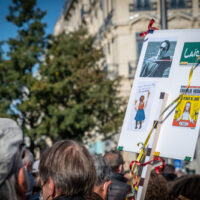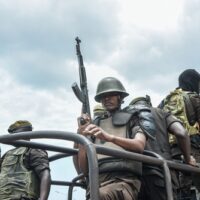Belgium (Brussels Morning) Otto certainly cut a fine figure. He was tall (nearly 2 meters), athletic (an Olympic caliber fencing champion) with movie star good looks. Many believed Otto bore a strikingly similar appearance to the famous dashing Hollywood star Errol Flynn. Otto had a long, dramatic facial scar (from fencing) that only added to his swashbuckling persona. In many ways, Otto was a larger than life. He was a charismatic historical figure— but he also had a menacing sinister side to his personality. This aspect of his identity was never more apparent than his World War II experience in Belgium. Meet Otto Skorzeny…
Otto Skorzeny (1908-1975) was born in Vienna, Austria into a family with a long, distinguished history of military service. As a young man, Otto joined the Austrian branch of the Nazi party in 1932. After completing numerous daring commando raids (more about these raids later), Otto became one of Adolf Hitler’s favorites. As the Führer’s bodyguard, Otto was assigned to carry out an operation that Hitler believed could change the course of World War II. The special operation (called Operation Greif) was purposed with the mission to recapture the Allied-held bridges over Belgium’s strategic Meuse River. Hitler envisioned a commando operation whereby specially trained German soldiers, wearing American uniforms and traveling in captured American jeeps and tanks, could cause great disruption by roaming behind enemy lines.
There, they could upset communications, give false orders, spy, sabotage, and misdirect road traffic as the Allied troops advanced toward German soil during the infamous Battle of the Bulge. Otto was to form a special commando brigade comprised of 15 captured American tanks,20 armored cars, 100 jeeps,120 trucks, and 40 motorcycles replete with U.S. Army uniforms and helmets—all of which came from captured Americans. Additionally, he was to recruit 150 of Germany’s best English speakers. Once organized, these German English speakers were sequestered in a special camp where they conversed with captured American POW soldiers. They learned how to use American slang and idioms, chew gum like Americans, hold a cigarette, to swear, and learn American trivia, (e.g., the capitals of the states) and sports statistics.
Once assembled and behind enemy lines, Otto’s “American-attired” commando units initially had some successes around the Bastogne, Liège, and Namur fronts. The commandos were able to infiltrate enemy lines—-disrupting communications, blowing up ammunition and fuel dumps, reporting on Allied troop movements, and generally wreaking havoc.
The American army was caught off-guard. But more than anything else, Operation Greif provoked an American overreaction that bordered on widespread panic. So great was the confusion that the U.S. Army began to “see spies and saboteurs everywhere.” The idea of German commando troops freely moving in their midst turned Americans into victims of their nightmarish fears.
All up and down the Allied chain of command American soldiers collectively became paranoid. Vehicles stopping at checkpoints were halted, occupants searched and were asked to prove their nationality by answering questions about American culture that only a “native” American would know. (e.g. “What is the state capital of New York?”). Another way of checking was to make the soldier in question lower their trousers to check that they were wearing American regulation underwear.
A wrong answer, a slow response, or a hint of a foreign accent resulted in an arrest at gunpoint. Rumors began to fly with panic growing on a grand scale. Some accounts reveal that Americans even began to shoot other Americans in cases of mistaken identity. In one instance an American brigadier general who did not know the name of the baseball team in Chicago was arrested and held for half a day until the matter was cleared up. Even British field Marshall Bernard Montgomery when stopped, refused to answer questions, then ordered his driver to speed through a checkpoint. The American guards shot out his tires. So endemic was the hysteria that General Eisenhower was placed under round-the-clock protection after one captured German commando, confessed that part of his mission was to assassinate Eisenhower.
Ultimately Operation Greif failed to achieve their mission of securing the bridges over the Meuse River. One of Skorzeny’s commando units was captured near Aywaille, Belgium, less than 20 miles south of the Meuse. They were found to have to have German papers, spoke with an accent, and failed a trivia question. They were arrested, interrogated, and sentenced to death by firing squad five days later. The element of surprise had been lost. Of the many German commando troops to wear American uniforms behind the enemy lines only eight returned to Germany. But Otto was one of them…
Otto Skorzeny’s venture into the Ardennes of Belgium was not his first nor his last “cloak and dagger” commando venture. In the early prewar years, Skorzeny had parachuted his way to remote mountains of Iran to contact dissident mountain tribes. He encouraged them to sabotage Allied shipments into the Soviet Union via the Trans-Iranian Railway. In 1943, this time using hang gliders, he pulled off a daring rescue (called Operation Oak) of Hitler’s ally Benito Mussolini who had been kidnapped by Italians resisting German occupation. After the war, Skorzeny was tried for war crimes. While interred at an American military tribunal in Dachau he escaped most ironically.
German SS officers who had entered the camp dressed in American military police uniforms, smuggled out Otto incognito. Otto would hide out in a small farm in Bavaria for the next few years before covertly moving on to Madrid where he was an “advisor” to intelligence operations in Francoist Spain. At one point Skorzeny went to Egypt where he trained a unit of Arab Egyptian volunteers in commando tactics for use against the British troops stationed in the Suez Canal. One of those commandos was Yassar Arafat who would later plan raids into Israel via the Gaza strip. But in one of history’s most ironic twists, in 1963 former SS Nazi Otto Skorzeny was recruited by Israel’s notorious intelligence agency the Mossad. The irony of Hitler’s most dynamic commando being consul to the Jewish state of Israel is beyond rich.
Inarguably World War II was a nightmare in a thousand different ways. The weaponry, death, and destruction have left an indelible stain on humanity. Yet despite all the evil, this does not preclude the fact that dynamic, intrepid, and colorful figures did indeed emerge. Otto Skorzeny — his operation in Belgium and his subsequent life story, speaks to that point.



